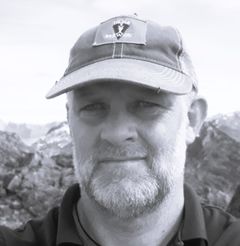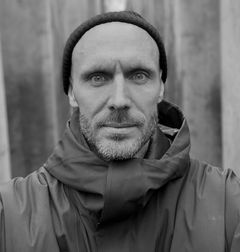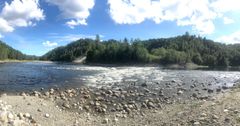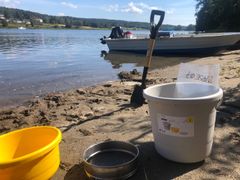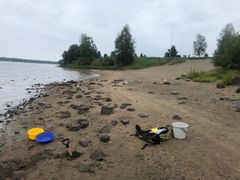New geological study: Scandinavia was born in Greenland
The oldest Scandinavian bedrock was 'born' in Greenland according to a new geological study from the University of Copenhagen. The study helps us understand the origin of continents and why Earth is the only planet in our solar system with life.
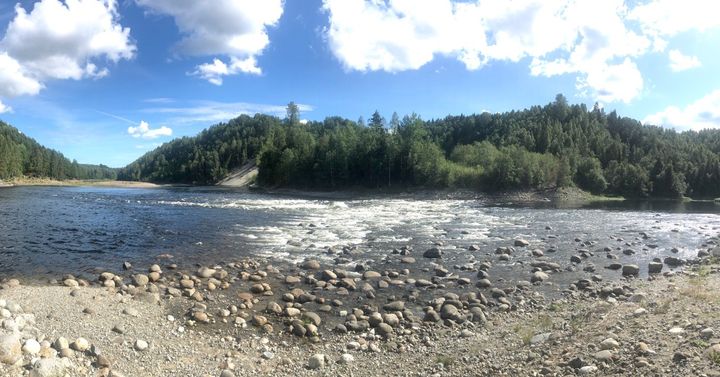
In a Finnish outcrop nestled between some of Northern Europe's oldest mountains, researchers have found traces of a previously hidden part of Earth's crust that points more than three billion years back in time and north towards Greenland.
These traces were found in the mineral zircon, which after chemical analyses, indicated to researchers from the Department of Geosciences and Natural Resource Management that the "foundation" upon which Denmark and Scandinavia rest, was probably 'born' from Greenland approximately 3.75 billion years ago.
"Our data suggest that the oldest part of Earth's crust beneath Scandinavia originates in Greenland and is about 250 million years older than we previously thought," says Professor Tod Waight, a geologist at the Department of Geosciences and Natural Resource Management.
The researchers’ study of the zircon showed that, in several ways, its chemical fingerprint matches those of some of the oldest rocks on the planet found in West Greenland’s North Atlantic Craton.
"The zircon crystals we found in river sand and rocks from Finland have signatures that point towards them being much older than anything ever found in Scandinavia, while matching the age of Greenlandic rock samples. At the same time, the results of three independent isotope analyses confirm that Scandinavia's bedrock was most likely linked to Greenland," says Department of Geosciences and Natural Resource Management researcher Andreas Petersson.
A water world without oxygen
Denmark, Sweden, Norway and Finland rest atop a part of Earth's crust known as the Fennoscandian Shield, or the Baltic Shield. The researchers believe that it broke away from Greenland as a "seed" and shifted for hundreds of millions of years until it "took root" where Finland is today.
Here, the plate grew as new geological material accumulated around it, until it became Scandinavia. At the time of the crust’s detachment from Greenland, the planet looked very different than today.
"Earth was probably a watery planet, like in the movie Waterworld, but without any oxygen in the atmosphere and without emergent crust. But, because that’s so far back in time, we can’t be really be sure about what it actually looked like," says Tod Waight.
According to the researchers, the fact that Earth even has a continental crust composed of granite is quite special when they look out into space and compare it with other planets in our galactic neighborhood.
"This is unique in our solar system. And, evidence of liquid water and a granite crust are key factors when trying to identify habitable exoplanets and the possibility of life beyond Earth," explains Andreas Petersson.
Continents are the key to life
The new study adds pieces to a primordial continental puzzle that began long before life on Earth truly blossomed, but which has largely paved the way for both human and animal life.
"Understanding how continents formed helps us understand why ours is the only planet in the solar system with life on it. Because without fixed continents and water in between them, we wouldn't be here. Indeed, continents influence both ocean currents and climate, which are crucial for life on Earth," says Andreas Petersson.
Furthermore, the new study contributes to a growing number of studies which reject the means used thus far to calculate how continents have grown – especially during the first billion years of Earth's history.
"The most commonly used models assume that Earth’s continental crust began to form when the planet was formed, about 4.6 billion years ago. Instead, our and several other recent studies suggest that the chemical signatures showing growth of the continental crust can only be identified about a billion years later. This means that we may need to revise much of what we thought about how early continents evolved," says Professor Waight.
At the same time, results of the study add to previous research that found similar "seeds" from ancient crusts in other parts of the world.
"Our study provides us with another important clue in the mystery of how continents formed and spread across Earth – especially in the case of the Fennoscandian Shield. But there is still plenty that we don't know. In Australia, South Africa and India, for example, similar seeds have been found, but we’re unsure of whether they all come from the same "birthplace", or whether they originated independently of one another in several places on Earth. This is something that we would like to investigate more using the method we used in this study," concludes Professor Waight.
About the study
- The study demonstrates that the oldest part of Earth's crust beneath Scandinavia comes from Greenland and is about 250 million years older than once thought.
- Therefore, Denmark and Scandinavia’s geologic foundation was most likely connected to Greenland approximately 3.75 billion years ago.
- The researchers analysed zircons from modern river sand and rock samples from the remote Pudasjärvi and Suomujärvi regions of Finland, whose geological origins have been little studied.
- The zircon crystals found in the Finnish river sand originally crystallized in granitic magmas deep within the crust. These granites were then lifted to the surface and eroded to eventually form sand.
- The researchers used isotopic compositions of lead, hafnium and oxygen to trace the chemical fingerprint from the Fennoscandian Shield back to Greenland.
- The study has been published in the scientific journal Geology.
Nøgleord
Kontakter
Tod Waight
Professor
Department of Geosciences and Natural Resource Management (Geology section)
University of Copenhagen
todw@ign.ku.dk
Andreas Petersson
Researcher
Department of Geosciences and Natural Resource Management (Geology section)
University of Copenhagen
andreas.zircon@gmail.com
Michael Skov Jensen
Journalist and team coordinator
The Faculty of Science
University of Copenhagen
msj@science.ku.dk
+ 45 93 56 58 97
Billeder
Følg pressemeddelelser fra Københavns Universitet - Det Natur- og Biovidenskabelige Fakultet
Skriv dig op her, og modtag pressemeddelelser på e-mail. Indtast din e-mail, klik på abonner, og følg instruktionerne i den udsendte e-mail.
Flere pressemeddelelser fra Københavns Universitet - Det Natur- og Biovidenskabelige Fakultet
Vi skal være flexitarer: Skidtfisk og rogn kan gøre grønsagerne mindre kedelige26.4.2024 10:01:42 CEST | Pressemeddelelse
Svaret på en grøn omstilling af vores kostvaner er ikke, at vi alle skal være vegetarer. En sund og mere realistisk løsning er derimod flexitar-kost, hvor det animalske kommer fra havet og giver umami-smag til de ’kedelige’ grøntsager. Sådan lyder det fra gastrofysikeren Ole G. Mouritsen fra Københavns Universitet, som viser, hvordan man med en matematisk ligning kan udregne umami-potentialet i alt fra rogn og rejepasta til blåmuslinger og blæksputter.
Superradiant atoms could push the boundaries of how precisely time can be measured22.4.2024 14:22:28 CEST | Pressemeddelelse
Superradiant atoms can help us measure time more precisely than ever. In a new study, researchers from the University of Copenhagen present a new method for measuring the time interval, the second, mitigating some of the limitations that today’s most advanced atomic clocks encounter. The result could have broad implications in areas such as space travel, volcanic eruptions and GPS systems.
Super-lysende atomer kan skubbe grænsen for hvor præcist vi kan måle tiden22.4.2024 14:07:32 CEST | Pressemeddelelse
Superstrålende atomer kan hjælpe os med at måle tiden mere præcist, end vi kan i dag. I et nyt studie fremlægger forskere fra Københavns Universitet nemlig en ny metode til at måle sekundet, som kommer uden om det problem, som selv de mest avancerede atomure i dag døjer med. Resultatet kan få betydning for så forskellige ting som rumfart, vulkanudbrud og vores GPS-systemer.
Verdens tundra udleder overraskende mere CO2, når det bliver varmere17.4.2024 17:00:00 CEST | Pressemeddelelse
KLAUSULERET TIL DEN 17. APRIL KL. 17:00 Når det bliver varmere, vil den arktiske tundrajord formentlig frigive 30% mere CO2, end den gør i dag. Og det er næsten fire gange mere, end hvad man tidligere har estimeret. Det viser et stort internationalt studie, som forskere fra Københavns Universitet har bidraget til, og som netop er offentliggjort i tidsskriftet Nature.
Internet can achieve quantum speed with light saved as sound15.4.2024 11:16:35 CEST | Press release
Researchers at the University of Copenhagen’s Niels Bohr Institute have developed a new way to create quantum memory: A small drum can store data sent with light in its sonic vibrations, and then forward the data with new light sources when needed again. The results demonstrate that mechanical memory for quantum data could be the strategy that paves the way for an ultra-secure internet with incredible speeds.
I vores nyhedsrum kan du læse alle vores pressemeddelelser, tilgå materiale i form af billeder og dokumenter samt finde vores kontaktoplysninger.
Besøg vores nyhedsrum
